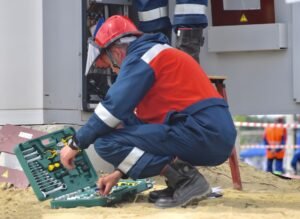DIY electrical work is a potentially cost-effective method for home improvements, but it requires proper tools, knowledge, and safety precautions. Common projects include installing light fixtures, replacing outlets, and rewiring rooms. However, electrical work carries inherent risks, and practitioners must exercise caution.
Before undertaking any electrical project, individuals should educate themselves on electrical safety fundamentals and acquire the necessary tools and equipment. Understanding local building codes and permit requirements is also essential. While DIY electrical work can be rewarding, it is crucial to recognize one’s limitations and consult or hire a licensed electrician for complex or potentially dangerous tasks.
Proper preparation and respect for electrical systems can help ensure successful and safe DIY electrical projects.
Key Takeaways
- DIY electrical work can be a cost-effective way to make repairs and improvements to your home, but it requires knowledge and caution.
- Safety equipment and gear such as gloves, goggles, and non-conductive footwear are essential for protecting yourself during electrical work.
- Basic hand tools like screwdrivers, pliers, and wire strippers are necessary for most electrical projects and repairs.
- Testing and measuring devices such as multimeters and voltage testers are crucial for ensuring the safety and functionality of electrical systems.
- Power tools like drills and saws can make electrical work more efficient, but they should be used with caution and proper training.
Safety Equipment and Gear
Essential Safety Equipment
This includes items such as insulated gloves, safety goggles, and a fire extinguisher. Insulated gloves are crucial for protecting your hands from electric shock, while safety goggles can prevent eye injuries from flying debris or sparks.
Protective Clothing
Additionally, having a fire extinguisher nearby is essential in case of an electrical fire. It’s also important to wear appropriate clothing, such as long sleeves and pants, to protect your skin from potential burns or cuts.
Minimizing Risks
By prioritizing safety equipment and gear, you can minimize the risk of accidents and injuries while working on DIY electrical projects.
Basic Hand Tools

Having a set of basic hand tools is essential for any DIY electrical project. Some of the most commonly used hand tools for electrical work include screwdrivers, pliers, wire strippers, and a utility knife. Screwdrivers are used for removing and installing screws on electrical devices, while pliers are essential for bending and cutting wires.
Wire strippers are used to remove the insulation from wires, while a utility knife can be used for cutting and stripping wires as well. It’s important to invest in high-quality hand tools to ensure durability and reliability during electrical projects. By having a well-stocked toolbox with basic hand tools, you can tackle a wide range of DIY electrical tasks with confidence and ease.
Testing and Measuring Devices
| Device | Accuracy | Range | Resolution |
|---|---|---|---|
| Multimeter | ±0.5% | 200mV – 1000V | 0.1mV – 1V |
| Oscilloscope | ±1% | 20MHz – 200MHz | 1mV – 10V |
| Function Generator | ±2% | 1Hz – 10MHz | 1mHz – 1kHz |
Testing and measuring devices are essential for ensuring the safety and functionality of electrical systems. Some of the most commonly used testing and measuring devices for DIY electrical work include a multimeter, voltage tester, and circuit tester. A multimeter is a versatile tool that can measure voltage, current, and resistance in electrical circuits, making it an essential device for troubleshooting and testing electrical systems.
A voltage tester is used to determine if a circuit is live or not, while a circuit tester can be used to identify faulty wiring or outlets. By having these testing and measuring devices on hand, you can accurately diagnose and troubleshoot electrical issues in your home.
Power Tools
Power tools can greatly enhance the efficiency and precision of DIY electrical projects. Some of the most commonly used power tools for electrical work include a drill/driver, reciprocating saw, and rotary tool. A drill/driver is essential for drilling holes and driving screws in electrical installations, while a reciprocating saw can be used for cutting through walls or materials when running new wiring.
A rotary tool is versatile for cutting, grinding, and sanding in tight spaces where larger power tools may not be practical. When using power tools for electrical work, it’s important to follow safety precautions and use them in accordance with the manufacturer’s instructions to prevent accidents or injuries.
Wire and Cable Management Tools

Common Wire and Cable Management Tools
Some of the most commonly used wire and cable management tools for DIY electrical work include cable ties, cable staples, and cable management clips.
Functions of Wire and Cable Management Tools
Cable ties are used to secure and bundle wires together, while cable staples can be used to secure cables to walls or surfaces. Cable management clips are useful for organizing and routing cables along walls or baseboards.
Benefits of Proper Wire and Cable Management
By using these wire and cable management tools, you can ensure that your electrical installations are tidy, safe, and free from potential hazards such as tripping over loose cables.
Specialty Electrical Tools
In addition to basic hand tools and power tools, there are several specialty electrical tools that can be useful for specific DIY electrical projects. Some of these specialty tools include fish tape, conduit benders, and wire fish sticks. Fish tape is used for pulling wires through walls or conduit, making it essential for running new wiring in existing structures.
Conduit benders are used for shaping metal conduit into bends or curves, while wire fish sticks can be used to route wires through tight spaces or conduits. These specialty electrical tools can greatly simplify the process of running new wiring or making modifications to existing electrical systems. In conclusion, DIY electrical work can be a rewarding and practical way to improve your home, but it’s important to approach it with caution and respect for the potential dangers involved.
By prioritizing safety equipment and gear, investing in high-quality hand tools and testing devices, using power tools responsibly, and utilizing wire and cable management tools as well as specialty electrical tools when necessary, you can tackle a wide range of DIY electrical projects with confidence and ease. However, if you’re ever unsure about how to proceed with an electrical project or feel uncomfortable working with electricity, it’s always best to consult with a professional electrician to ensure the safety and integrity of your home’s electrical system.
If you’re interested in learning more about electrical tools, you might also want to check out this article on bucks, the agile and majestic herbivores. It’s always fascinating to learn about the different uses of electricity in various industries, including the tools used to harness its power.
FAQs
What are electrical tools?
Electrical tools are devices or instruments that are used to work with electricity. These tools are designed to help electricians and other professionals safely and effectively perform electrical work.
What are some common electrical tools?
Some common electrical tools include wire strippers, pliers, screwdrivers, voltage testers, multimeters, circuit finders, and power drills. These tools are essential for tasks such as installing, repairing, and maintaining electrical systems.
Why is it important to use the right electrical tools?
Using the right electrical tools is important for safety and efficiency. Using the wrong tools can lead to accidents, damage to equipment, and poor quality work. It is important to use tools that are specifically designed for electrical work and to use them properly.
How should electrical tools be maintained?
Electrical tools should be regularly inspected for damage and wear, and any damaged tools should be repaired or replaced. It is important to keep tools clean and dry, and to store them properly when not in use. Regular maintenance and proper storage can help prolong the life of electrical tools and ensure their safe and effective use.




















+ There are no comments
Add yours